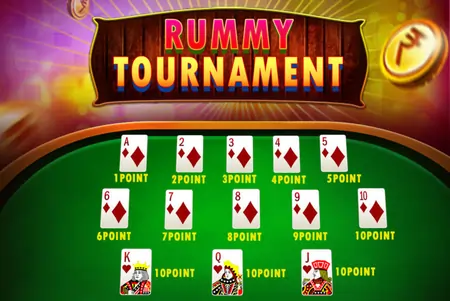A rummy tournament is a 2 to 6 player game played with at least 2 pack of 53 cards. This game is played in a knock-out format.

to participate in a rummy tournament, the first crucial step is to secure your seat by registering in advance. Given the limited number of seats available, it’s important to join early to guarantee your spot.
Each table in the tournament can accommodate a maximum of 6 players and provides a fixed amount of tournament chips. You can enjoy these tournaments on your desktop or by downloading the free rummy application for a seamless experience on your Android device.
Here’s a comprehensive guide on how to play a rummy tournament:
- Use at least two packs of 53 cards each, including one printed joker.
- Begin the game with a toss to determine the first player.
- Randomly distribute 13 cards to each player.
- Select a random joker from the deck, which can be any suit’s Ace if a printed joker is chosen. This means there can be up to 9 jokers in a game, depending on the number of packs used.
- Place the next card from the pack in the open deck, signaling the start of the game.
Regarding the rummy points system in tournaments:
- The player who declares their hand first receives zero points.
- Face cards carry ten points each, while numbered cards carry points based on their face value.
- Wild and printed jokers have zero points.
- If a player drops at the beginning, they receive twenty points, and if they drop after picking a card, they get forty points. A player who declares before completing their goal receives eighty points.
- Losing players’ scores are determined by the points carried by the cards in their hand. If a losing player doesn’t have a pure sequence, all the points of the cards in their hand are counted. If they have two sequences with a pure sequence, only the cards not arranged in sequences and sets are counted. The maximum score a player can receive is eighty points.
- Players who miss three consecutive turns receive a middle drop of 40 points and are automatically dropped from the game.
Strategic Play in Rummy Tournaments
In addition to nailing the points system, having a solid game plan is crucial in rummy tournaments. A smart strategy involves not only creating pure sequences early on to avoid a high score, but also keeping a close eye on what your opponents are up to. Remember, getting rid of high-value cards can really save you from a tough hand. Plus, being flexible in forming sequences and sets with the cards you have can totally change the game.
Oh, and don’t forget about the discard pile! Paying attention to what your opponents are throwing away can give you a competitive edge. By keeping track of their discards, you can get a sense of what sequences or sets they’re going for and adjust your own strategy accordingly. Ultimately, practice, staying focused, and being adaptable are the keys to success.
FAQ:-
Q: How do I register for a rummy tournament?
A: You can register by signing up on the rummy tournament’s website or mobile application, where you need to fill in the required details and secure your seat by registering in advance due to the limited seats available.
Q: What is the maximum number of players allowed at a rummy table?
A: Each rummy table can accommodate up to a maximum of 6 players.
Q: How many packs of cards are used in a tournament, and do they include jokers?
A: Tournaments use at least two packs of 53 cards each, which includes one printed joker per pack. A random card is also selected to function as a joker, which could increase the total number of jokers in a game.
Q: Can I rejoin a tournament after being automatically dropped for missing turns?
A: Players missing three consecutive turns receive a middle drop of 40 points and are dropped
Q: What is the maximum score a player can incur in a tournament?
A: The maximum score a player can receive is eighty points, irrespective of the actual card points in their hand if they don’t have a pure sequence.

I am Rahul Verma, an eloquent writer and digital marketer.I am passionate about online gaming and creating money-making content, having an envious portfolio for popular brands like mpl.live and getrushapp.com. Digital marketing is my plus as I have struggled in this for six long years’ day in and day out. I create compelling content which engages readers related to games or apps, and they get valuable information about earning money through different platforms. My depth of know-how about the gaming industry trends have equipped me to write more than 4000 articles. My aim is to write for informative content which is entertaining as well for the readers.








